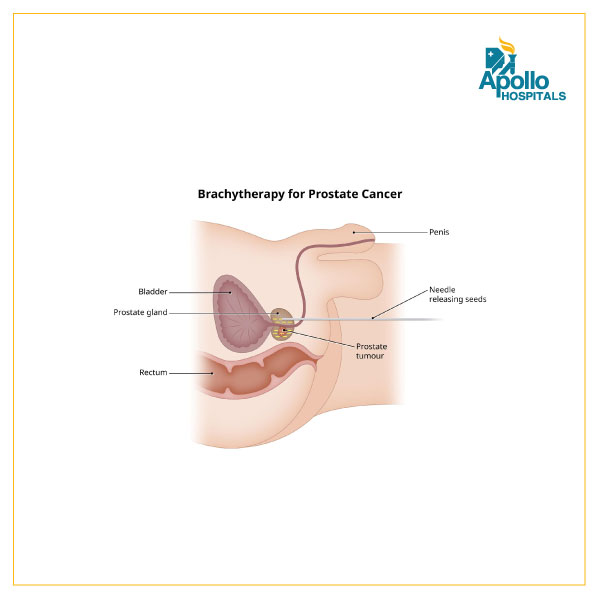Brachytherapy: A Targeted Approach to Treating Cancer
- 907 Views
- Apollo Hospital Mumbai
- August 22, 2023
- Oncology

Verified by Dr. Sandeep De, Consultant Radiation Oncology, Apollo Cancer Centres, Navi Mumbai.
Brachytherapy is an advanced and specialized form of cancer treatment that delivers radiation therapy directly to the tumor site, offering a precise and effective way to fight cancer. Unlike traditional radiation therapy, which emits radiation from outside the body, brachytherapy involves placing a radiation source inside or very close to the tumor. This method allows for a more focused and controlled delivery of radiation, minimizing damage to surrounding healthy tissues.
How does brachytherapy work?
A small radioactive source is placed within or near the tumor, providing a concentrated dose of radiation to destroy cancer cells. The placement of the source can vary based on the type and location of the cancer. The types of brachytherapy include:
- Internal Brachytherapy: In this approach, a tiny device containing radioactive material is inserted directly into the body, either temporarily or permanently. This method is commonly used for treating prostate, cervical, and breast cancers. Once the desired dose is delivered, the device is removed.
- Surface Brachytherapy: This technique involves applying the radiation source directly onto the skin’s surface, typically for treating skin cancers or other superficial tumors. The radiation is focused on the targeted area, minimizing exposure to nearby healthy tissues.
- Temporary Brachytherapy: In this method, a radioactive source is inserted into the body for a specific period and then removed. It is often used for gynecological cancers, such as cervical and endometrial cancer. Temporary brachytherapy delivers a high dose of radiation directly to the tumor site, minimizing damage to surrounding tissues.
- Permanent Brachytherapy: Also known as seed implantation, this approach involves placing small, radioactive seeds directly into or near the tumor. These seeds emit low levels of radiation over time, gradually delivering the required dose. Permanent brachytherapy is commonly utilized for prostate cancer treatment.
Which cancers require brachytherapy?
- Prostate Cancer: Brachytherapy has gained prominence as an effective treatment option for localized prostate cancer. Radioactive seeds are implanted into the prostate gland, where they release radiation over several months, targeting the cancer cells while preserving healthy tissue.
- Gynecological Cancers: For cervical, endometrial, and vaginal cancers, brachytherapy is used to precisely deliver radiation to the tumor bed. This helps reduce the risk of recurrence and offers improved outcomes.
- Breast Cancer: In cases of breast cancer, brachytherapy can be used as a part of breast-conserving therapy. A specialized balloon or catheter is placed within the surgical cavity, allowing targeted radiation to be delivered directly to the site of concern.
- Head and Neck Cancers: Brachytherapy may be employed for treating cancers in the head and neck region. It offers the advantage of sparing critical structures, such as the salivary glands, while effectively treating the tumor.
- Skin Cancer: Surface brachytherapy is used for treating skin cancers, including basal cell and squamous cell carcinomas. A radioactive source is applied directly to the skin lesion, minimizing damage to healthy tissues.
What are the advantages of brachytherapy?
- Precise treatment: Brachytherapy’s ability to focus radiation directly on the tumor reduces exposure to nearby healthy tissues, minimizing side effects.
- Shorter treatment duration: Brachytherapy often requires a shorter treatment period compared to traditional external radiation therapy, enhancing patient convenience.
- Localized therapy: The internal delivery of radiation allows for a higher dose to be applied directly to the tumor, improving tumor control and potentially leading to better outcomes.
- Minimal discomfort: Patients usually experience minimal discomfort during and after the procedure, and they can often resume normal activities sooner.
- Collaborative decision-making: Medical teams work closely with patients to determine the most suitable treatment plan, ensuring personalized care.
It’s important to note that while brachytherapy offers numerous advantages, its application depends on factors such as cancer type, stage, and individual health considerations. As with any medical treatment, discussing the potential benefits, risks, and alternatives with your healthcare provider is essential in making informed decisions.
Connect with our specialist, Dr. Sandeep De, Consultant Radiation Oncology, Apollo Cancer Centres, Navi Mumbai.
Call 022 6280 6280 for an appointment.
- January 20, 2025
Total Knee Replacement: The Role of Robotics
- January 20, 2025
Awareness and Precautions Against Human Metapneumovirus (HMPV)
- January 20, 2025
Aortic Root Replacement
- December 26, 2024
Robotic Surgery in Orthopedics
- Bone Marrow Transplant3
- Cardiac sciences44
- Cardiology1
- Child Care7
- Clinical Excellence33
- Cosmetology2
- COVID-199
- Diseases4
- Emergency10
- Emergency8
- Endocrinology1
- ENT5
- Fetal Medicine1
- Gastroenterology8
- General Medicine11
- General Surgery4
- Genomic Medicine2
- Gynecology1
- Health14
- Hematology2
- Kidney Transplant5
- Kidney Transplant2
- Liver Transplant6
- Neonatology1
- Nephrology2
- Nephrology & transplant1
- Nephrology & Urology4
- Neurosciences21
- Neurosciences1
- Nutrition/Diet1
- Obstetrics & Gynecology9
- Obstetrics & Gynecology4
- Oncology3
- Oncology93
- Ophthalmology1
- Orthopedic15
- Patient Speak1
- Pediatric Surgery4
- physiotherapy2
- Psychologist2
- Pulmonology4
- Rheumatology1
- Robotic Suregry1
- Robotic Surgery11
- Spine1
- Uncategorized111
- Urology1
- Women Care5
